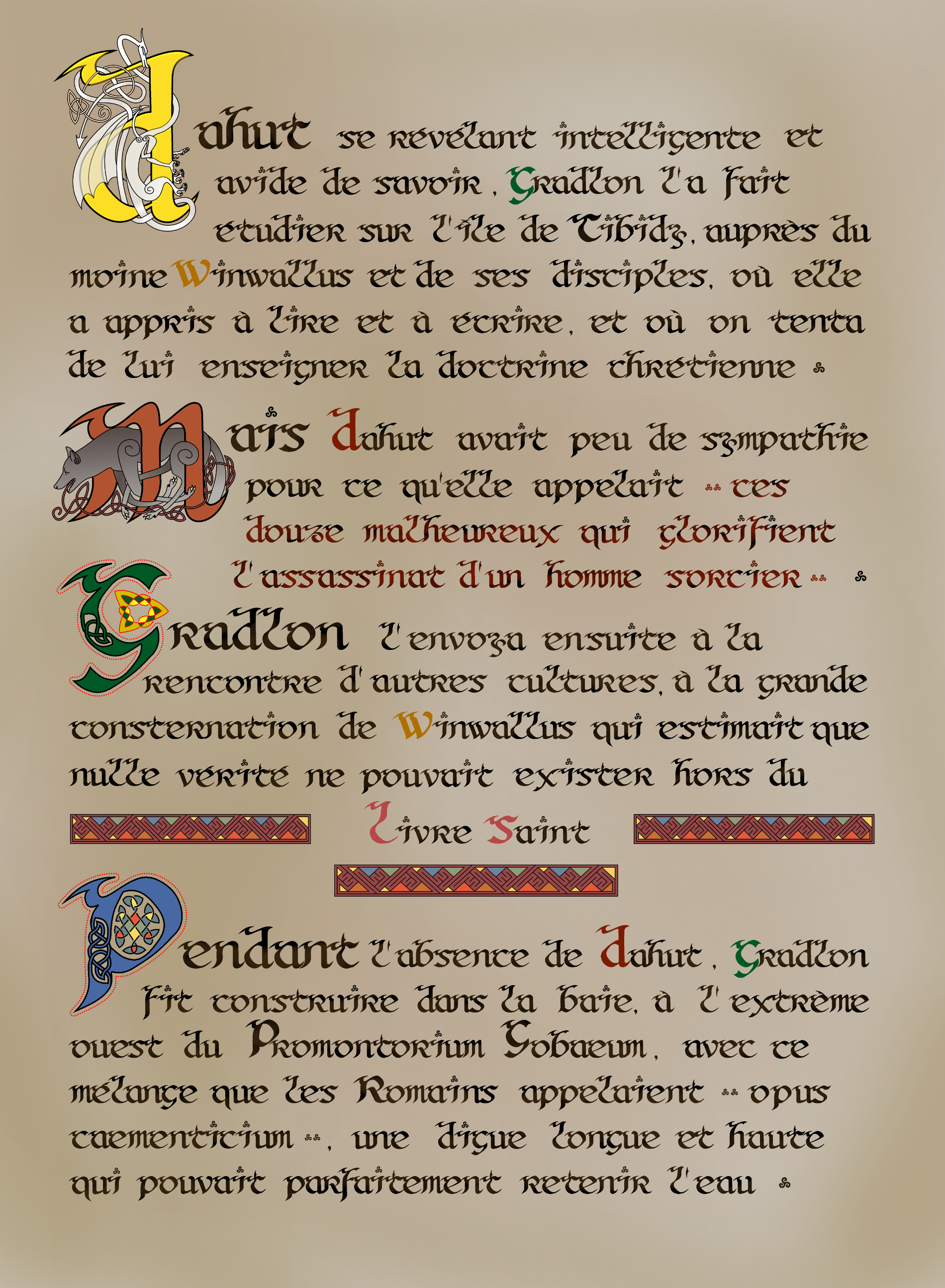fol. 2v
Dahut se révélant intelligente et avide de savoir, Gradlon l'a fait étudier sur l'île de Tibidy(1), auprès du moine Winwallus(2) et de ses disciples, où elle a appris à lire et à écrire, et où on a également essayé de lui enseigner la doctrine chrétienne. Mais Dahut avait peu de sympathie pour ce qu'elle appelait "ces douze malheureux qui glorifient l'assassinat d'un homme sorcier". Gradlon l'envoya ensuite à la rencontre d'autres cultures, à la grande consternation de Winwallus qui estimait que nulle vérité ne pouvait exister hors du Livre Saint.
Pendant l’absence de Dahut, Gradlon fit construire dans la baie à l'extrême ouest du Promontorium Gobaeum(3)(4), avec ce mélange que les Romains appelaient 'opus caementicium', une digue longue et haute qui pouvait parfaitement retenir l'eau(5).
(1)Tibidy est un îlot situé à l'embouchure de la rivière du Faou. Îlot où, selon la légende, Saint Guénolé aurait débarqué au cours du cinquième siècle.
(2)Il paraît qu'il existe une cinquantaine de formes de son nom, allant de Wynwallow à des variantes telles que Wingaloeus, Waloway, Wynolatus, Vinguavally, Vennole, Valois, Ouignoualey, Gweno, Gunnolo et Bennoc. (Source: 'The Catholic Encyclopedia')
Nous le connaissons sous le nom de Guénolé; pour mon histoire, j'ai choisi la forme latine Winwallus.
(3)Gobaeum Promontorium: les environs de la pointe du Raz, donc probablement ce qu'on appelle maintenant le Cap Sizun.
(4)Baie de Douarnenez ou Baie des Trépassés? Ahes ou Dahut? Gradlon ou Gralon ou Grattilonius? Ys ou Is? Winwallus ou Guénolé? Des choix. J'habite au Cap Sizun, donc je revendique la Baie des Trépassés pour situer Ker-Is.
C'est comme avec les standards du jazz: la même mélodie de base, mais chaque interprète la joue dans son propre style, et les improvisations peuvent aller dans toutes les directions.
(5)Les structures contemporaines en béton devraient durer 100 ans. Les structures portuaires sous-marines en 'béton romain' ont déjà survécu pendant plus de 2000 ans.
fol.2v
Dahut being intelligent and eager to learn, Gradlon made her study, on the island of Tibidy(1), with the monk Winwallus(2) and his disciples, where she learned to read and write, and where they also tried to teach her the Christian doctrine. But Dahut had little sympathy for what she called "those twelve unfortunates who glorify the assassination of a sorcerer". Gradlon then sent her on a journey to get to know other cultures, much to the dismay of Winwallus who believed that the truth could only be found in the Holy Book.
(3)(4), with the mixture that the Romans called 'opus caementicium'(5), a long and high barrier that could perfectly hold back the water(4).
(1)Tibidy is an islet located at the mouth of the Faou river. An island where, according to legend, Saint Guénolé landed during the fifth century.
(2)It seems there are some fifty forms of his name, ranging from Wynwallow through such variants as Wingaloeus, Waloway, Wynolatus, Vinguavally, Vennole, Valois, Ouignoualey, Gweno, Gunnolo, to Bennoc. (Source: 'The Catholic Encyclopedia')
We know him as Guénolé; for my tale I chose for the Latin form Winwallus.
(3)Gobaeum Promontorium: the surroundings of the Pointe du Raz, so probably what is now called Cap Sizun.
(4)Baie de Douarnenez or Baie des Trépassés? Ahes or Dahut? Gradlon or Gralon or Grattilonius? Ys or Is? Winwallus or Guénolé? Choices. I live in the Cap Sizun, so I claim the Baie des Trépassés to situate Ker-Is.
It is like with jazz standards: the same basic melody, but every interpreter plays it in his own style, and the improvisations can go in all directions.
(5)Contemporary concrete structures are expected to last a 100 years. The underwater port structures made of 'Roman concrete' have already survived for more than 2,000 years.
Cliquez l'image pour une meilleure qualité.
Click on the picture for a better quality.

